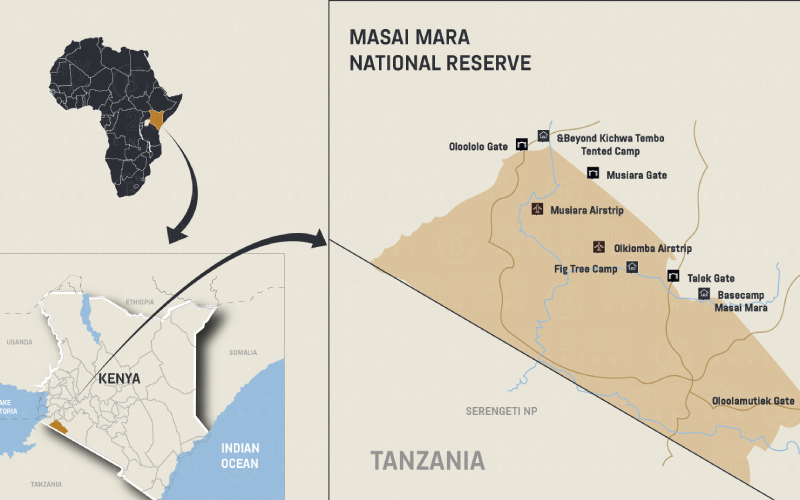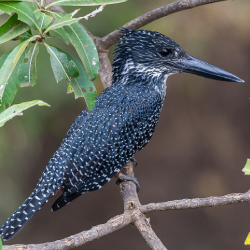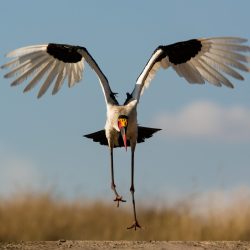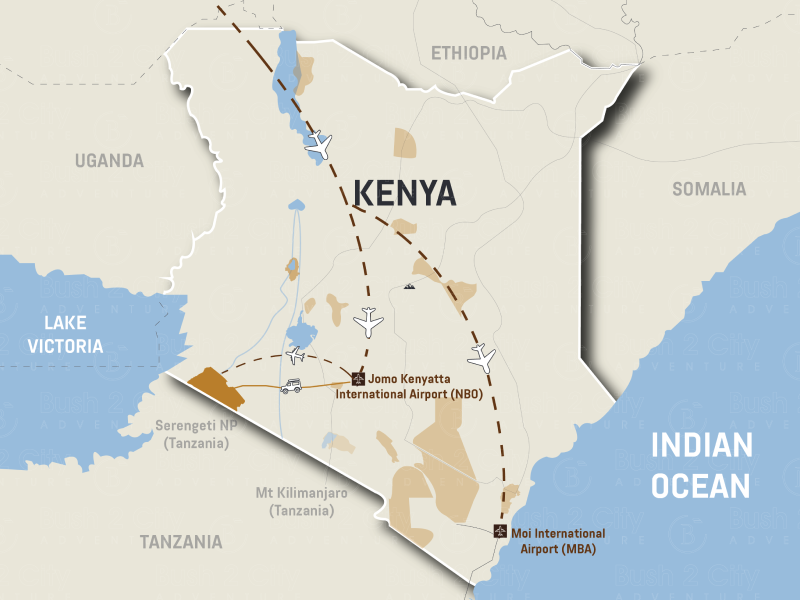

Masai Mara National Reserve is recognized as Kenya’s top wildlife destination. It consistently offers sightings of three of the Big Five, with leopards and black rhinos being more elusive—the latter occasionally spotted in the northern reaches of the Mara Triangle. Esteemed as one of the best places in East Africa to watch big cats, the reserve is also home to a range of smaller predators, including bat-eared foxes, black-backed jackals, and spotted hyenas. The reserve boasts a rich variety of antelope, featuring impala, reedbuck, Thomson’s gazelle, eland, and topi. Furthermore, buffalo, elephants, and giraffes are frequently seen, known for their placid nature and ease of spotting.
The legendary wildebeest migration stands as one of the planet’s most mesmerizing wildlife phenomena. While each year brings its own unique dynamics, usually between July and August, and sometimes stretching into September, millions of animals embark on a monumental journey from northern Tanzania’s Serengeti National Park to the Masai Mara. The riveting spectacle of the Mara River crossing marks a pinnacle moment in this epic migration. As October unfolds, the migration begins its gradual return journey back to Tanzania.
Wildlife viewing in the Masai Mara is rewarding year-round. However, the dry season (June to October) offers the best opportunities for observing a wide range of wildlife. For the ultimate wildebeest migration experience, plan your visit between August and October. Remember that the migration’s exact timing can vary slightly each year, as the animals follow the rainfall in search of greener pastures.






Birdwatching in the Masai Mara is a delight year-round, but the most rewarding experiences unfold from November to April when migrants from Europe and North Africa grace the region with their presence. This window coincides with the Wet season (November to May), showcasing many species adorned in their vibrant breeding plumage. Conversely, the Dry season, spanning from June to October, offers prime conditions for comprehensive wildlife viewing.
450+
Nov to Apr

This period offers a delightful experience in the park, characterized by lovely weather. Expect mostly sunny days with mild temperatures and remember to bring warm clothing for early morning game drives.
June, July & August – While occasional rains may occur, the weather is predominantly sunny and dry. Afternoon temperatures are comfortable, typically reaching 25°C (77°F), though it can feel quite chilly in the evenings and early mornings with temperatures around 12°C (54°F).
September & October – These months continue to be dry, though occasional rainfall is possible. Temperatures start to rise in October, averaging around 27°C (81°F) and occasionally higher, with chilly early mornings around 14°C (57°F).
The region frequently experiences overcast and cloudy conditions, with afternoon showers being quite common. Daytime temperatures are relatively stable, while early mornings tend to be cool at around 14°C (57°F)—make sure to pack some warm clothes.
November & December – ‘Short rains’: Rainfall typically lessens starting in November, with afternoons warming up to an average of 27°C (81°F).
January & February: This period serves as a bridge between the short and long rain seasons, featuring sporadic showers. The precise timing of these drier intervals is difficult to pinpoint.
March, April & May – ‘Long rains’: The height of the rainy season is in April. Although all-day rain is rare, expect frequent and vigorous afternoon thunderstorms. Paths can become slick and hard to travel. Mornings are marginally warmer, averaging around 14°C (57°F).

Your primary entry point into Kenya will likely be Jomo Kenyatta International Airport (NBO), located approximately 15 kilometers southeast of Nairobi. The Masai Mara is approximately 260 kilometers from Nairobi, a journey that typically takes 5-6 hours by road to the main Sekenani Gate. If you’re staying in the northern region of the park, including the Mara North and Mara Triangle conservancies, expect an additional travel time of approximately 70 kilometers (43 minutes).
Alternatively, you can drive from Lake Nakuru National Park to the Masai Mara, covering around 235 kilometers (150 miles) in approximately 6 hours.

To travel to Kenya, look for flights arriving at Jomo Kenyatta International Airport (NBO) and compare the best deals that fit your travel plans. Once you’ve booked your flight ticket, please share the details with your travel consultant before confirming the safari trip to ensure everything aligns perfectly. Below is a list of airlines flying to Kenya.
When you book our package tour, we’ll take care of arranging charter flights between parks for your convenience.
The reserve and nearby conservancies are equipped with at least nine airstrips, each servicing different lodges. Most domestic flights, including those to popular destinations like the Masai Mara, depart from Wilson Airport (WIL), situated 6 km (4 mi) south of Nairobi. You have the option to book flights directly through several domestic airlines, or allow us to handle the reservations for you:
AirKenya operates flights from Nairobi’s Wilson Airport to a variety of locations including Kisumu, Migori, Samburu, Nanyuki, Meru, and international destinations such as Tarime in Tanzania and Entebbe in Uganda. We are happy to make these bookings on your behalf.
Mombasa Air Safari offers routes connecting the Masai Mara with Amboseli, Tsavo West, Diani Beach, Malindi, and Mombasa. We can manage these bookings for you.
Safarilink provides services between Nairobi’s Wilson Airport and cities like Mombasa, Diani Beach, and Migori. We can arrange these flights for you as well.
Please visit our “Getting There” or “FAQ on Kenya” page to find detailed information about passport, visa, COVID-19, and other entry requirements
We consider the Masai Mara National Reserve to be a very safe destination for tourists. Traveler-targeted crime is exceptionally uncommon in Kenya’s wildlife zones. Although, as with most places globally, cities can experience higher crime rates. It’s wise to follow usual safety protocols in urban environments (please see ‘Cities & Urban Areas: Safety Precautions’ below for guidance). When you’re on an organized tour, you can feel confident about your security from crime-related concerns.
You may require certain vaccinations before traveling to Kenya. We advise consulting with your doctor or a travel clinic beforehand. Additionally, the Masai Mara region is a malaria zone, and taking antimalarials is strongly recommended. To further reduce the risk of mosquito bites, it’s wise to use mosquito repellent that contains DEET and to cover up during dusk.
Observing wildlife in the Masai Mara is typically quite secure, provided you heed the guidance of your guide. Rare occurrences of incidents exist. To learn more, refer to the ‘Wildlife Viewing Safety Precautions’ provided below.


Masai Mara National Reserve is recognized as Kenya’s top wildlife destination. It consistently offers sightings of three of the Big Five, with leopards and black rhinos being more elusive—the latter occasionally spotted in the northern reaches of the Mara Triangle. Esteemed as one of the best places in East Africa to watch big cats, the reserve is also home to a range of smaller predators, including bat-eared foxes, black-backed jackals, and spotted hyenas. The reserve boasts a rich variety of antelope, featuring impala, reedbuck, Thomson’s gazelle, eland, and topi. Furthermore, buffalo, elephants, and giraffes are frequently seen, known for their placid nature and ease of spotting.
The legendary wildebeest migration stands as one of the planet’s most mesmerizing wildlife phenomena. While each year brings its own unique dynamics, usually between July and August, and sometimes stretching into September, millions of animals embark on a monumental journey from northern Tanzania’s Serengeti National Park to the Masai Mara. The riveting spectacle of the Mara River crossing marks a pinnacle moment in this epic migration. As October unfolds, the migration begins its gradual return journey back to Tanzania.
Wildlife viewing in the Masai Mara is rewarding year-round. However, the dry season (June to October) offers the best opportunities for observing a wide range of wildlife. For the ultimate wildebeest migration experience, plan your visit between August and October. Remember that the migration’s exact timing can vary slightly each year, as the animals follow the rainfall in search of greener pastures.






Birdwatching in the Masai Mara is a delight year-round, but the most rewarding experiences unfold from November to April when migrants from Europe and North Africa grace the region with their presence. This window coincides with the Wet season (November to May), showcasing many species adorned in their vibrant breeding plumage. Conversely, the Dry season, spanning from June to October, offers prime conditions for comprehensive wildlife viewing.
450+
Nov to Apr

This period offers a delightful experience in the park, characterized by lovely weather. Expect mostly sunny days with mild temperatures and remember to bring warm clothing for early morning game drives.
June, July & August – While occasional rains may occur, the weather is predominantly sunny and dry. Afternoon temperatures are comfortable, typically reaching 25°C (77°F), though it can feel quite chilly in the evenings and early mornings with temperatures around 12°C (54°F).
September & October – These months continue to be dry, though occasional rainfall is possible. Temperatures start to rise in October, averaging around 27°C (81°F) and occasionally higher, with chilly early mornings around 14°C (57°F).
The region frequently experiences overcast and cloudy conditions, with afternoon showers being quite common. Daytime temperatures are relatively stable, while early mornings tend to be cool at around 14°C (57°F)—make sure to pack some warm clothes.
November & December – ‘Short rains’: Rainfall typically lessens starting in November, with afternoons warming up to an average of 27°C (81°F).
January & February: This period serves as a bridge between the short and long rain seasons, featuring sporadic showers. The precise timing of these drier intervals is difficult to pinpoint.
March, April & May – ‘Long rains’: The height of the rainy season is in April. Although all-day rain is rare, expect frequent and vigorous afternoon thunderstorms. Paths can become slick and hard to travel. Mornings are marginally warmer, averaging around 14°C (57°F).

Your primary entry point into Kenya will likely be Jomo Kenyatta International Airport (NBO), located approximately 15 kilometers southeast of Nairobi. The Masai Mara is approximately 260 kilometers from Nairobi, a journey that typically takes 5-6 hours by road to the main Sekenani Gate. If you’re staying in the northern region of the park, including the Mara North and Mara Triangle conservancies, expect an additional travel time of approximately 70 kilometers (43 minutes).
Alternatively, you can drive from Lake Nakuru National Park to the Masai Mara, covering around 235 kilometers (150 miles) in approximately 6 hours.

To travel to Kenya, look for flights arriving at Jomo Kenyatta International Airport (NBO) and compare the best deals that fit your travel plans. Once you’ve booked your flight ticket, please share the details with your travel consultant before confirming the safari trip to ensure everything aligns perfectly. Below is a list of airlines flying to Kenya.
When you book our package tour, we’ll take care of arranging charter flights between parks for your convenience.
The reserve and nearby conservancies are equipped with at least nine airstrips, each servicing different lodges. Most domestic flights, including those to popular destinations like the Masai Mara, depart from Wilson Airport (WIL), situated 6 km (4 mi) south of Nairobi. You have the option to book flights directly through several domestic airlines, or allow us to handle the reservations for you:
AirKenya operates flights from Nairobi’s Wilson Airport to a variety of locations including Kisumu, Migori, Samburu, Nanyuki, Meru, and international destinations such as Tarime in Tanzania and Entebbe in Uganda. We are happy to make these bookings on your behalf.
Mombasa Air Safari offers routes connecting the Masai Mara with Amboseli, Tsavo West, Diani Beach, Malindi, and Mombasa. We can manage these bookings for you.
Safarilink provides services between Nairobi’s Wilson Airport and cities like Mombasa, Diani Beach, and Migori. We can arrange these flights for you as well.
Please visit our “Getting There” or “FAQ on Kenya” page to find detailed information about passport, visa, COVID-19, and other entry requirements
We consider the Masai Mara National Reserve to be a very safe destination for tourists. Traveler-targeted crime is exceptionally uncommon in Kenya’s wildlife zones. Although, as with most places globally, cities can experience higher crime rates. It’s wise to follow usual safety protocols in urban environments (please see ‘Cities & Urban Areas: Safety Precautions’ below for guidance). When you’re on an organized tour, you can feel confident about your security from crime-related concerns.
You may require certain vaccinations before traveling to Kenya. We advise consulting with your doctor or a travel clinic beforehand. Additionally, the Masai Mara region is a malaria zone, and taking antimalarials is strongly recommended. To further reduce the risk of mosquito bites, it’s wise to use mosquito repellent that contains DEET and to cover up during dusk.
Observing wildlife in the Masai Mara is typically quite secure, provided you heed the guidance of your guide. Rare occurrences of incidents exist. To learn more, refer to the ‘Wildlife Viewing Safety Precautions’ provided below.
Embarking on an African safari promises an adventure of a lifetime, showcasing the continent’s rich wildlife, breathtaking landscapes, and diverse cultures. While safaris are widely considered safe, especially those organized through reputable tour operators, it’s prudent to take certain precautions to ensure a smooth and secure experience. Here are some essential safety tips to consider:
Traveling through Africa offers an enriching experience filled with breathtaking landscapes, diverse cultures, and unparalleled wildlife encounters. While it’s generally safe, especially on organized tours or safaris, navigating urban environments requires a bit of savvy to ensure your trip remains worry-free. Here are some straightforward tips to keep in mind, whether you’re exploring bustling metropolises or serene landscapes:
Exploring the wild through a safari adventure is an exhilarating experience that brings you closer to nature’s most fascinating wildlife. Whether you opt for a guided tour with an experienced professional or decide to navigate the trails on a self-drive journey, safety is paramount to ensure an enjoyable and incident-free adventure. Here are some essential safety guidelines and tips to help you navigate your safari safely:

